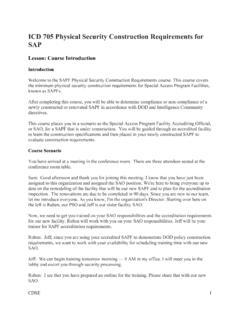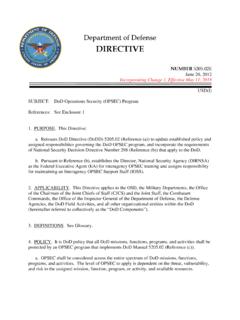Transcription of Security Clearance Process: Answers to Frequently Asked ...
1 Security Clearance Process: Answers to Frequently Asked Questions Michelle D. Christensen Analyst in Government Organization and Management October 7, 2016 Congressional Research Service 7-5700 R43216 Security Clearance Process: Answers to Frequently Asked Questions Congressional Research Service Summary This report provides a primer on some of the fundamental aspects of the Security Clearance process, using a Frequently Asked Questions format. A Security Clearance is a determination that an individual whether a direct federal employee or a private contractor performing work for the government is eligible for access to classified national Security information.
2 A Security Clearance alone does not grant an individual access to classified materials. Rather, a Security Clearance means that an individual is eligible for access. In order to gain access to specific classified materials, an individual should also have a demonstrated need to know the information contained in the specific classified materials. There are three levels of Security clearances: Confidential, Secret, and Top Secret, which correspond to the levels of sensitivity of the information that a cleared individual will be eligible to access. In addition, there are two major categories of classified information that require additional handling and access restrictions Sensitive Compartmented Information (SCI), which includes intelligence sources, methods, and processes, and Special Access Programs (SAPs), which are highly sensitive projects and programs.
3 These categories exist for classified information that has been deemed particularly vulnerable. Eligibility standards and investigative requirements for access to SCI and SAPs are higher than for access to information otherwise classified at the same level, which further restricts the number of individuals eligible for access. Federal employees and private contractors must be cleared in order to gain access to classified materials. An individual may not obtain or initiate a Security Clearance on his or her own. A sponsoring federal agency initiates the process and will make the final Security Clearance determination based on a background investigation.
4 Although the process involves a number of stages, the key steps to obtaining and maintaining a Security Clearance are (1) agency sponsorship and submission of Clearance application materials; (2) a background investigation, the extent of which may vary by level of Clearance ; and (3) adjudication to determine whether an individual is deemed eligible for access. Adjudication and final Clearance determinations are generally handled by the sponsoring agency. To maintain a Security Clearance , an individual is also subject to periodic reinvestigations and, more recently, continuous monitoring and evaluation of his or her background.
5 Previously, the Office of Personnel Management, Federal Investigative Services (OPM-FIS) oversaw approximately 95% of all background investigations. On October 1, 2016, President Obama transferred responsibility for investigative work and related services from OPM-FIS to the newly established National Background Investigations Bureau (NBIB). Like OPM-FIS, the NBIB conducts some of the investigative work itself and contracts the rest out to private firms. Typically, the costs of a background investigation, including background investigations of private contractors, are paid for by the requesting agency. While the final determination to grant or deny a Security Clearance is typically made by the requesting agency, with certain exceptions a Security Clearance granted by one agency must be accepted by other agencies.
6 It is difficult, however, to determine the degree to which reciprocity occurs between agencies. Security Clearance Process: Answers to Frequently Asked Questions Congressional Research Service Contents Introduction .. Error! Bookmark not defined. What Is a Security Clearance ? .. Error! Bookmark not defined. What Is the Difference Between a Security Clearance and a Suitability Check?Error! Bookmark not defined. What Are the Levels of Security Clearances? .. Error! Bookmark not defined. Who Is Eligible to Obtain a Security Clearance ? .. Error! Bookmark not defined. Can an Individual Obtain a Security Clearance on His or Her Own?
7 Error! Bookmark not defined. Are Constitutional Officers ( , the President, Members of Congress) Required to Hold a Security Clearance to Access Classified Information? .. Error! Bookmark not defined. Are Congressional Staff and Judicial Staff Required to Hold a Security Clearance to Gain Access to Classified Information? .. Error! Bookmark not defined. How Many Individuals Hold Security Clearances in Total and at Each Level?Error! Bookmark not defined. What Are the Major Aspects of the Security Clearance Process? .. Error! Bookmark not defined. Are Private Contractors Subject to the Same Clearance Process as Direct Government Employees?
8 Error! Bookmark not defined. Which Agencies Are Responsible for Conducting Background Investigations?Error! Bookmark not defined. Who Pays for Background Investigations? .. Error! Bookmark not defined. On Average, How Long Does it Take to Obtain a Security Clearance ?Error! Bookmark not defined. Are There Guidelines or Standards for Approving, Denying, or Revoking a Security Clearance ? .. Error! Bookmark not defined. Can the Outcome of a Security Clearance Determination Be Appealed?Error! Bookmark not defined. May a Security Clearance Granted by One Agency Be Accepted by Other Agencies?Error! Bookmark not defined. Tables Table 1.
9 Security Clearances Approved and Total Clearances Held as of FY2012 .. 6 Appendixes Appendix. Additional CRS Products on Security Clearances and Protection of Classified Information .. Error! Bookmark not defined. Contacts Author Contact Information .. Error! Bookmark not defined. Security Clearance Process: Answers to Frequently Asked Questions Congressional Research Service 1 Introduction The Security Clearance process is designed to determine the trustworthiness of an individual prior to granting him or her access to classified national Security information. The process has evolved since the early 1950s, with antecedents dating to World War This report highlights some of the fundamental aspects of the process by providing Answers to Frequently Asked What Is a Security Clearance ?
10 A Security clearance3 is a determination that an individual whether a federal employee or a private contractor is eligible for access to classified national Security A Security Clearance may only be granted by a federal agency, and generally only upon completion of a background investigation. Using information obtained during the background investigation, the agency will make a determination as to the character and trustworthiness of the individual, and decide if he or she will be eligible for access to classified national Security information. A Security Clearance alone does not grant an individual access to specific classified materials.














